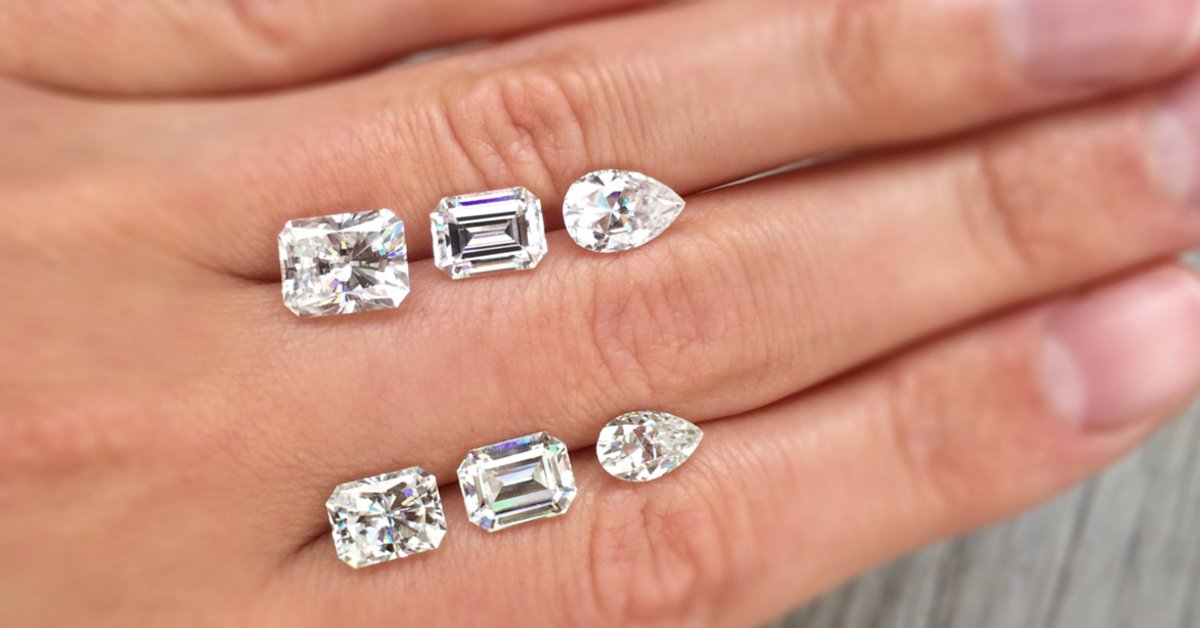
Diamond colour grades change in unexpectedly tiny increments.
Diamond colours range from D to Z, and as they trinkle down the alphabet the colour hue becomes more visibly prominent. Z is not a dark brown or yellow, yes, the colour is visible but far less pronounced than you would imagine.
Internet diamond colour-sheets aren’t accurate. Just see them as a visual parable to just show that colour intensifies as you slide down to Z on the colour scale.
I can tell you right here before we sail off; G and H are white to any pair of eyes. You’re better off focusing on some other characteristics like cut-grade and size when your in this boat.
Splitting the colour range into brackets helps distinguishing ice-white shades, from those lower down in the spectrum when considering diamonds for your engagement or wedding ring. Comparing a diamond colour to any adjacent colour is majoring in minors.
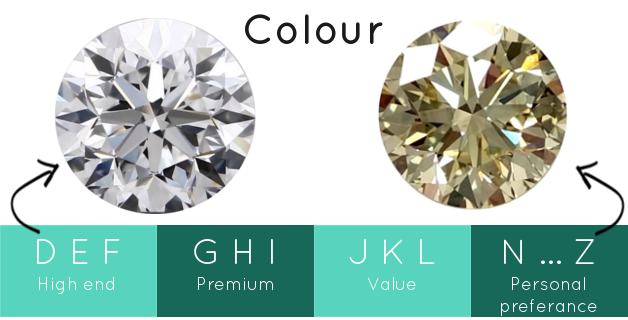
There’s a lot of shades between N and Z – things escalate slooowly.
Working within a set budget; whether R30 000 or R500 000, it comes down to your personal preference when maximising what you have in mind for the piece.
- DEF (High-End) – When your budget allows you to indulge in the best of the best without compromising on clarity and cut all while keeping size at the weight you like. We all sometimes pay beyond the practical benefit limit, especially when it comes to spoiling someone we love. True story.
- GHI (Premium) – These diamonds are, when cut and polished well, whiter than 90% of those that you spot in the engagement ring wilderness. Dropping the premium of DEF colours, you can focus on upping the size which dramatically affects the appearance of an engagement ring in its totality. This is the bracket I recommend if you want a white, no compromise, diamond.
- JKL (Value) – This spectrum is referred to as commercial white in the diamond industry. They set up surprisingly white, and would be your run of the mill colour range. Pair these with blue fluorescence (more here), and you can up the perceived colour by at least a shade.
- N-Z: These shades aren’t bad or poor. You will see a hint of colour, but some women like the added warmth. These shades aren’t white, and that’s sometimes exactly what a couple is after. It’s kind of like using a sepia filter on a photo. Just be vigilant to ensure the diamonds aren’t milky and cloudy.
Look, these brackets aren’t set in stone. We don’t even out prices so sometimes we buy in DEF colours at minor premiums to GH. Those are relative bargains. Ask to see both brackets/categories, and consider the relative value for yourself.
How to compare diamond clarities.
Clarity refers to the number, type, and size of natural imperfections and impurities in a diamond. It’s graded from internally flawless (IF) to I3 (visibly included). Since every diamond is inspected and graded at 10X magnification top clarities are as clean to the naked eye as those slightly down the line.
Viewing clarities on a computer or smartphone screen is way beyond 10X, and just unfair when trying to imagine how the diamond will end up looking in that custom engagement ring.
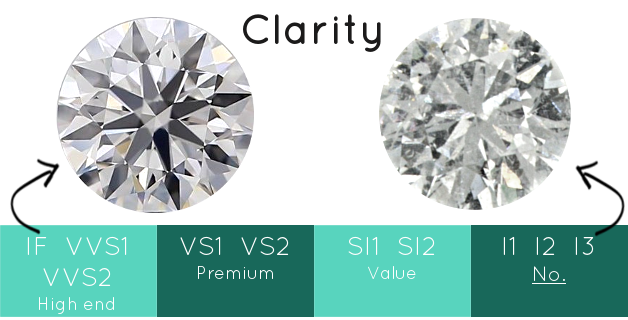
I recommend you focus on diamonds that are clean to the naked eye. As a diamond increases in size the inclusions are easier to spot, but VS1 would be eye clean all the way up to 2,00ct. There’s no benefit to paying a large premium for something that’s perfectly clean at 10X. Your eyes are 1X.
Want to see for yourself? Visit us in Rosebank or Pretoria and you can view diamond colour shades and clarities side by side in a sterile light environment You might need to put some of your imagination to work to tell them apart. Set up a time for a visit here.
Common questions;
To frame the rest of the post lets work with a comment on our “The Price of a 1,00ct Engagement Ring in South Africa” blog from Samantha.
She questioned some price comparisons in the post. The comment distills down to 5 questions, and after the brief introduction it’s easier to tackle;
Can a G VS2 be compared to H VS1 on price and appearance? (Absolutely – see explanation here).
Can a H VVS2 be compared to a G VS2? (They’re actually priced identically per carat – see for yourself here).
Does clarity and colour equally affect the price as you move up or down by a grade in each? (Broadly speaking; yes – see below).
Does the cut grade influence price? (Yes. But you shouldn’t be shopping for diamonds that were messed up by an unskilled polisher. We only stock Very Good and Excellent cut grades, and both look great. Excellent cuts may carry a tiny premium, but in the larger scheme its close to negligible). Find out why “Cut” is the most import C in the 4C model.
Do jewellers pull a slight of hand by offering diamonds compromised by the little understood fluorescence grade? (Of course. Jewellers who fight on price will play with many variables beyond the 4C’s. We take a no compromise approach and that leaves us as, probably, the only prominent jeweller that doesn’t offer a price match show/guarantee. To better understand fluorescence reading “11 Ways To Ensure You’re Buying A High Quality Diamond” is a great start.
Let’s run through the details, and get Samantha the information she needs. She’s of opinion that certain comparisons were in the “how on earth” category. That’s just misinformation – no harsh feelings.
When you’re comparing quotes from different jewellers you need to keep a few things in mind;
Differences in specifications offered are normal.
Working with the mentioned colour shades and clarities, the very important cut grade (quality of workmanship when polishing the diamond), 10 most popular shapes and the effect and intensity of fluorescence you have 690 000 possible specification combinations… that excludes the weight of the diamond.
No jeweller on Earth carries the whole range.
So, sometimes a jeweller might offer you a diamond with a slightly better or lower spec than you enquired on because that’s the closest they have to your request. It’s never apples to apples in the 690 000 option diamond world.
We compared 8 quotes from other decent local jewellers, and a 1,00ct diamond engagement ring from Poggenpoel came in at 15% under the average price.
Price is a poor measure for quality in this business.
We’re obsessed with our craftsmanship and pricing currently is solely to help more people get that perfect engagement ring, and hopefully be thrilled and send a friend over for a coffee and engagement ring. We’re building something we’re proud of here.
Craftsmanship varies drastically from one jeweller to the next. There are great jewellers in South Africa, but we’ve remade horrors from competitors.
For reference, here’s the 2018 comparison that triggered the questions;
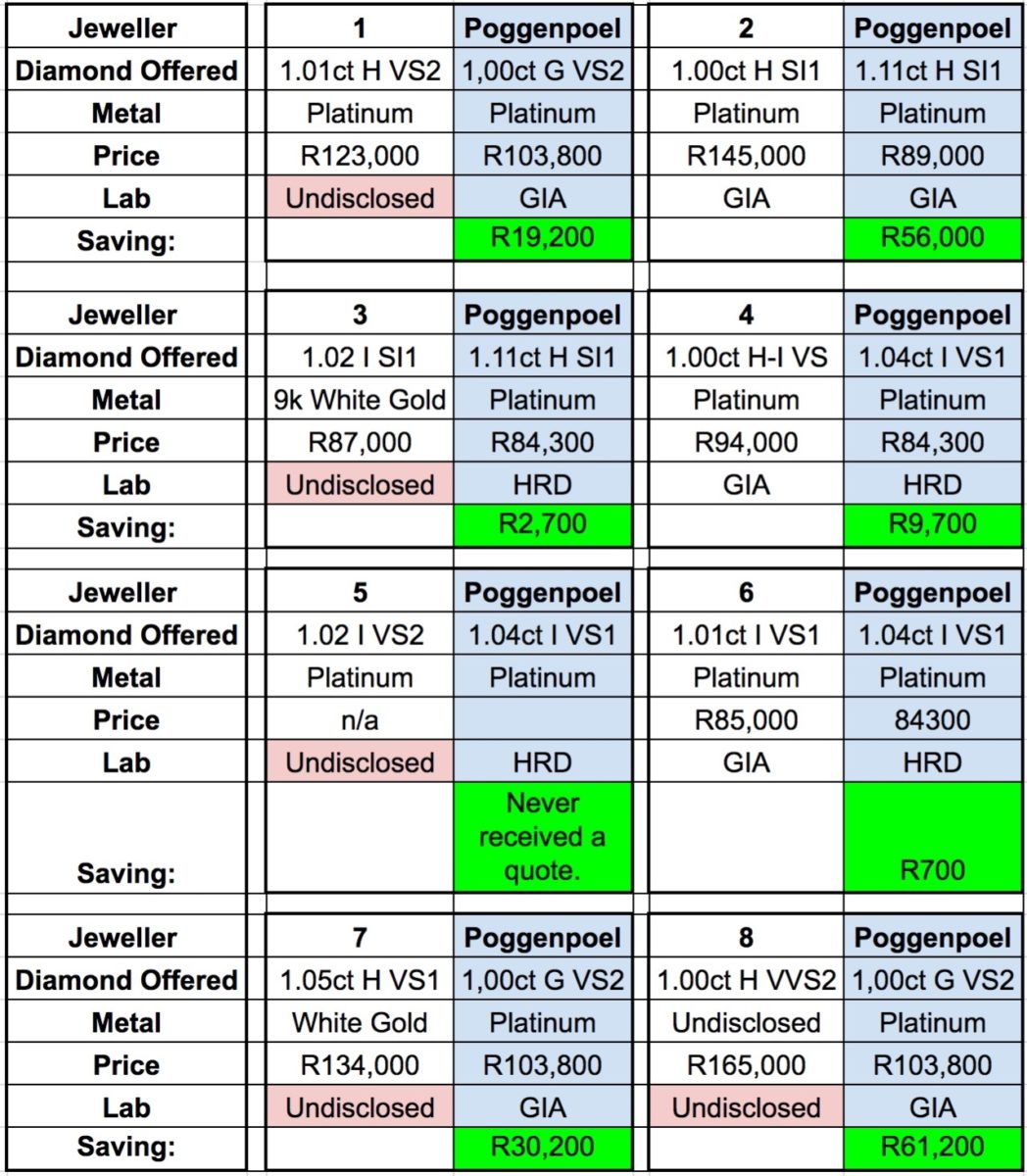
We offered superior diamonds in comparison 1 – 6. Comparison 7 and 8 are specification combinations that sell at pretty much the same price according to the extensive price research and surveying conducted bi-weekly in the New York Diamond District by the international Rapaport Group. What a mouth full.
Here’s the Rapaport pricing on comparison 8 which seems to be an “unfair” comparison at first glance: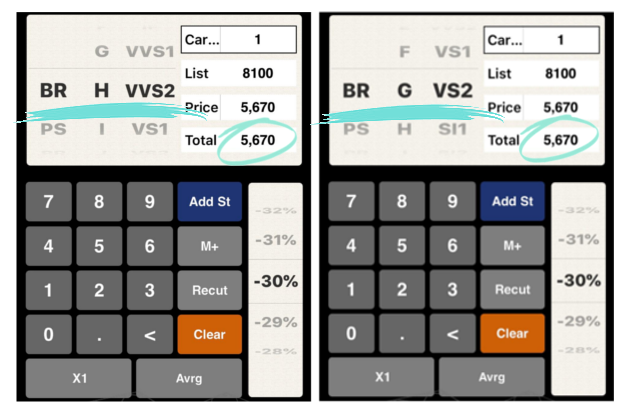
Identical recommended asking price at 30% discount to the New York Diamond District asking street prices.
The diamond grading laboratory matters.
Jewellers 7 and 8 didn’t offer diamonds graded by the GIA, and if they were re-certified by the GIA, or reputable labs like HRD (Belgium) and DIA as our favourite local choice, the diamond’s specifications might (often) drop a colour or clarity grade. The GIA is strict and consistent. Smaller grading laboratories sometimes seem to be tempted to take a more lenient approach to give jewellers favourable gradings in an effort to retain their business. If a diamond is over-graded a jeweller can raise the price, or make the price seem too good to be true for the graded specifications.
If you submit the same diamond to 2 laboratories; say GIA and LAB X you will probably get differences on the grading report. The disclaimers on diamond certificates of all shapes and sizes state that it’s merely their opinion… but still you can find yourself with two completely different certificates;
- GIA: 1,00ct G SI1, Very Good Cut.
- Lab X: 1,00ct F VS2, Excellent Cut.
Using the Rapaport pricing and factoring into the cut grade, recommended pricing would be;
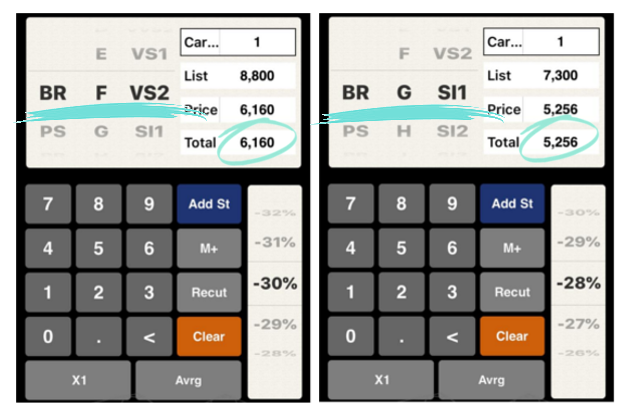
At the same sales price, say $5200, the F VS2 option looks better at the same price, but it’s the same diamond. It’s… sleight of hand.
So, unfortunately, if the diamond offered by another jeweller is not GIA certified, I wont bet it’s been accurately and critically examined and certified. Whether its a reflection of the diamonds true, honest characteristics is an unknown. We don’t like unknowns.
*The labs mentioned are those we deal with. Industry readers, please don’t send me correspondence. Your lab may be perfectly honest. Thanks for reading though.
Let’s merge colour and clarity into 3 brackets that reflect quality ranges usefully;
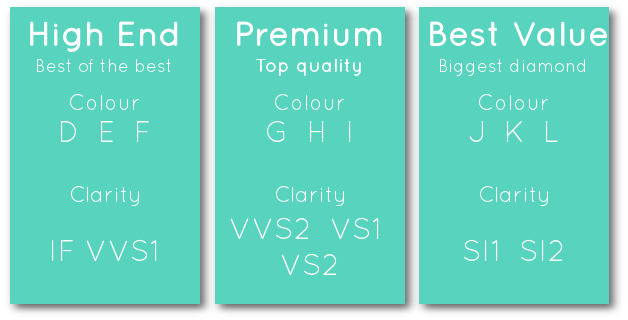
You do get D-colour, SI2 diamonds – but broadly sticking within these ranges offers the best diamond for your designated budget. “Premium” is our best selling range, and usually the choice for an upscale engagement ring’s centre-piece… at least around here.
Sticking to a certain quality bracket you can, as a rule of thumb, assume a G VS2 has close to the same price as when flipping the colour down, and the clarity up – each by a single grade to H VS1. Assuming other specifications like weight and cut are equal.

*to…
The last topic raised by Samantha regarding fluorescence is often overlooked, and the catch in most bargain basement diamonds. For a thorough look into this please head over to “How Does Fluorescence Affect The Appearance And Price Of A Diamond?” which should be live in 48 hours, or for now take a look at “11 Ways To Ensure You’re Buying A High Quality Diamond”.
Where to from here?
It’s never too early to reach out.
You’ll receive no pressure information from a crew that really cares about getting you to way more than just a “yes”.
Make it extra special.
And please make Poggenpoel your first stop.
No one cares more about your ring than we do. That will be crystal clear after your consultation and studio visit.
Uniquely, we have full-time brilliant designers in our studios (Rosebank and Pretoria) that can discuss certain elements you have in mind. They’re fantastic and knock an 8/10 idea to a 10/10. That’s what you want, and we live for.
We’d love to be part of your story, and make you part of ours.

Your officially invited to visit our jewellery studios in Pretoria and Rosebank to see feel and experience top-end diamonds for a variety of budgets.
For questions, quotes and consultation bookings please feel free to reach out on info@poggenpoel.com or get in touch via your preferred channel.
Take care.
Johan Poggenpoel, Co-Founder.
T; 012 111 0525 (Pretoria) | 010 020 6811 (Johannesburg)
E; info@poggenpoel.com
Instagram:https://www.instagram.com/poggenpoeljewel/
Facebook; www.facebook.com/poggenpoel
